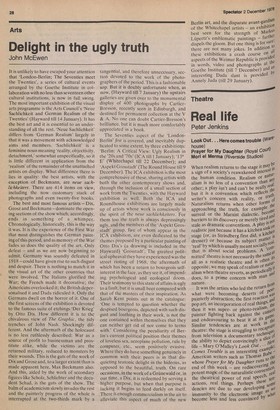Arts
Delight in the ugly truth
John McEwen
It is unlikely to have escaped your attention that 'London-Berlin; The Seventies meet the Twenties', a series of cultural events arranged by the Goethe Institute in collaboration with no less than seventeen other cultural institutions, is now in full swing. The most important exhibition of the visual arts programme is the Arts Council's 'Neue Sachlichkeit and German Realism of the Twenties' (Hayward till 14 January). It has the best art and it is essential to an understanding of all the rest. 'Neue Sachlichkeit' differs from 'German Realism' largely in that it was a movement with acknowledged aims and members. 'Sachlichkeit' is a feminine noun meaning 'reality, objectivity, detachment,' somewhat unspecifically, so it is little different in application from the 'realism' of the remainder of the unattached artists on display. What difference there is lies in quality: the best artists, with the exception of Beckmann, are neue sachlichkeiters. There are 414 items on view, including the now customary stack of photographs and even twenty-five books. The best and most famous artists — Dix, Grosz and Beckmann —dominate the opening sections of the show which, accordingly, ends in something of a whimper. Chronologically, historically, this is the way it was. It is the experience of the First War that most distinguishes the German painting of this period, and as memory of the War fades so does the quality of the art. Only defeat — and as we are now beginning to admit, Germany was soundly defeated in 1918 —could have given rise to such disgust and despair. There is nothing to match it in the visual art of the other countries that were involved. The Italians glorified the War; the French made it decorative; the Americans overlooked it; the British depersonalised it and Dada ridiculed it. Only the Germans dwell on the horror of it. One of the first screens of the exhibition is devoted to the famous suite of etchings 'Der Krieg' by Otto Dix. How different it is to the chivalrous view of The Graphic, the tidy trenches of John Nash. Shockingly different. And the aftermath of the holocaust is no less ruthlessly described: War as a source of profit to businessman and prostitute alike, while the victims are the returned military, reduced to monsters by their wounds. This is the guts of the work of Dix and Grosz and, to a larger extent than is made apparent here, Max Beckmann also. And this, aided by the work of secondary figures like Scholz, Schlichter and the decadent Schad, is the guts of the show. The balm of academicism slowly invades the rest and the painterly progress of the whole is interrupted at the two-thirds mark by a tangential, and therefore unnecessary, section devoted to the work of the photographers of the period. This is a fashionable sop. But it is doubly unfortunate when, as now, (Hayward till 7 January) the upstairs galleries are given over to the monumental display of 400 photographs by CartierBresson, recently seen in Edinburgh, and destined for permanent collection at the V & A. No one can doubt Cartier-Bresson's brilliance, but it is much more comfortably appreciated in a book. The Seventies aspect of the 'LondonBerlin' fist is covered, and inevitably duplicated to some extent, by three exhibitions: 'Berlin: A Critical View: Ugly Realism in the '20s and '70s' (ICA till 1 January); '13° E' (Whitechapel till 22 December); and 'Aspekt Grosstade (The Round House till 9 December). The ICA exhibition is the most comprehensive of these, sharing artists with both the other contemporary shows and, through the inclusion of a small section of work from the Twenties, with the Hayward exhibition as well. Both the ICA and Roundhouse exhibitions are largely made up of artists whose work is consciously in the spirit of the neue sachlichkeiters. For them too the truth is always depressingly ugly, and the members of the 'Aspekt Grosstadt' group, fLve of whom appear in the ICA exhibition, are even dedicated to the themes proposed by a particular painting of Otto Dix's (a drawing is included in the Hayward) `Grosstade. The greatest political upheaval they have experienced was the street rioting of 1968, the aftermath of which has been a return to bourgeois selfinterest in the face, as they see it, of impending psychological and ecological doom. Their testimony to this state of affairs is ugly to a fault, but it is small beer compared with that of the masters of their inspiration. As Sarah Kent points out in the catalogue: 'One is tempted to question whether the despised bourgeois, depicted with such disgust and loathing in their work, is not the one contained within themselves that they can neither get rid of nor come to terms with.' Considering the peculiarity of Berlin's current political position their themes of loveless sex, aeroplane pollution, rule by computer, etc., seem positively evasive. Where they do have something genuinely in common with their peers is in that disquieting teutonic delight in the hideous, as opposed to the beautiful, truth. On rare occasions, in the work of a Grilnewald or, in our time, a Dix, it is redeemed by serving a higher purpose, but when that purpose is lacking it begins to feed darkly on itself. There i's enough commercialism in the air to alleviate this aspect of much of the new Berlin art, and the disparate avant-gardima of the Whitechapel artists — an exhibition best seen for the strength of Markus Liipertz's emblematic paintings — further dispels the gloom. But one thing is for sure: there are not many jokes. In addition WI these exhibitions a crash course en aIA aspects of the Weimar Republic is provide' in words, video and photographs at the Goethe Institute (till 7 December) and an interesting Dada slant is provided bY Annely Juda (till 29 January).






































 Previous page
Previous page